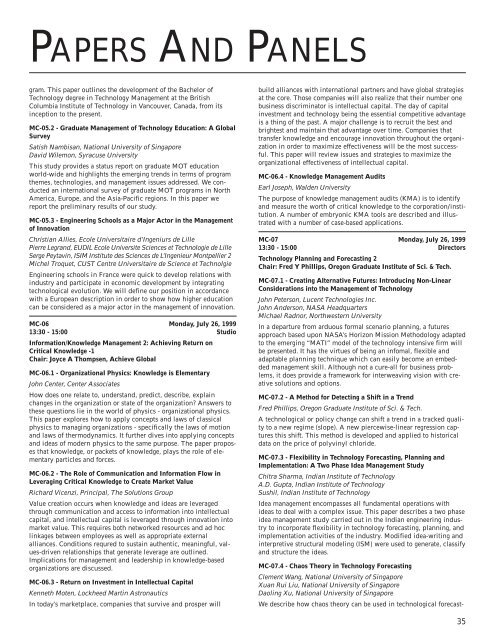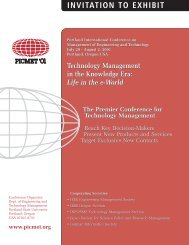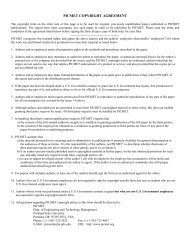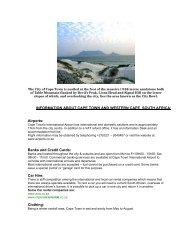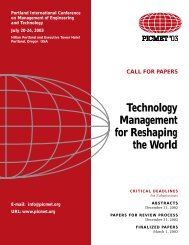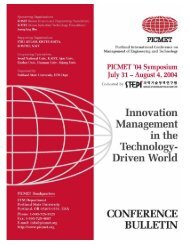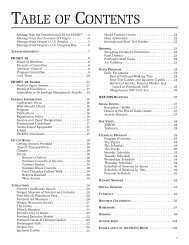Technology & Innovation Management: - PICMET Conference
Technology & Innovation Management: - PICMET Conference
Technology & Innovation Management: - PICMET Conference
Create successful ePaper yourself
Turn your PDF publications into a flip-book with our unique Google optimized e-Paper software.
PAPERS AND PANELS<br />
gram. This paper outlines the development of the Bachelor of<br />
<strong>Technology</strong> degree in <strong>Technology</strong> <strong>Management</strong> at the British<br />
Columbia Institute of <strong>Technology</strong> in Vancouver, Canada, from its<br />
inception to the present.<br />
MC-05.2 - Graduate <strong>Management</strong> of <strong>Technology</strong> Education: A Global<br />
Survey<br />
Satish Nambisan, National University of Singapore<br />
David Wilemon, Syracuse University<br />
This study provides a status report on graduate MOT education<br />
world-wide and highlights the emerging trends in terms of program<br />
themes, technologies, and management issues addressed. We conducted<br />
an international survey of graduate MOT programs in North<br />
America, Europe, and the Asia-Pacific regions. In this paper we<br />
report the preliminary results of our study.<br />
MC-05.3 - Engineering Schools as a Major Actor in the <strong>Management</strong><br />
of <strong>Innovation</strong><br />
Christian Allies, Ecole Universitaire d’Ingeniurs de Lille<br />
Pierre Legrand, EUDIL Ecole Universite Sciences et Technologie de Lille<br />
Serge Peytavin, ISIM Institute des Sciences de L’Ingenieur Montpellier 2<br />
Michel Troquet, CUST Centre Universitaire de Science et Technolgie<br />
Engineering schools in France were quick to develop relations with<br />
industry and participate in economic development by integrating<br />
technological evolution. We will define our position in accordance<br />
with a European description in order to show how higher education<br />
can be considered as a major actor in the management of innovation.<br />
MC-06 Monday, July 26, 1999<br />
13:30 - 15:00 Studio<br />
Information/Knowledge <strong>Management</strong> 2: Achieving Return on<br />
Critical Knowledge -1<br />
Chair: Joyce A Thompsen, Achieve Global<br />
MC-06.1 - Organizational Physics: Knowledge is Elementary<br />
John Center, Center Associates<br />
How does one relate to, understand, predict, describe, explain<br />
changes in the organization or state of the organization? Answers to<br />
these questions lie in the world of physics - organizational physics.<br />
This paper explores how to apply concepts and laws of classical<br />
physics to managing organizations - specifically the laws of motion<br />
and laws of thermodynamics. It further dives into applying concepts<br />
and ideas of modern physics to the same purpose. The paper proposes<br />
that knowledge, or packets of knowledge, plays the role of elementary<br />
particles and forces.<br />
MC-06.2 - The Role of Communication and Information Flow in<br />
Leveraging Critical Knowledge to Create Market Value<br />
Richard Vicenzi, Principal, The Solutions Group<br />
Value creation occurs when knowledge and ideas are leveraged<br />
through communication and access to information into intellectual<br />
capital, and intellectual capital is leveraged through innovation into<br />
market value. This requires both networked resources and ad hoc<br />
linkages between employees as well as appropriate external<br />
alliances. Conditions requred to sustain authentic, meaningful, values-driven<br />
relationships that generate leverage are outlined.<br />
Implications for management and leadership in knowledge-based<br />
organizations are discussed.<br />
MC-06.3 - Return on Investment in Intellectual Capital<br />
Kenneth Moten, Lockheed Martin Astronautics<br />
In today’s marketplace, companies that survive and prosper will<br />
build alliances with international partners and have global strategies<br />
at the core. Those companies will also realize that their number one<br />
business discriminator is intellectual capital. The day of capital<br />
investment and technology being the essential competitive advantage<br />
is a thing of the past. A major challenge is to recruit the best and<br />
brightest and maintain that advantage over time. Companies that<br />
transfer knowledge and encourage innovation throughout the organization<br />
in order to maximize effectiveness will be the most successful.<br />
This paper will review issues and strategies to maximize the<br />
organizational effectiveness of intellectual capital.<br />
MC-06.4 - Knowledge <strong>Management</strong> Audits<br />
Earl Joseph, Walden University<br />
The purpose of knowledge management audits (KMA) is to identify<br />
and measure the worth of critical knowledge to the corporation/institution.<br />
A number of embryonic KMA tools are described and illustrated<br />
with a number of case-based applications.<br />
MC-07 Monday, July 26, 1999<br />
13:30 - 15:00 Directors<br />
<strong>Technology</strong> Planning and Forecasting 2<br />
Chair: Fred Y Phillips, Oregon Graduate Institute of Sci. & Tech.<br />
MC-07.1 - Creating Alternative Futures: Introducing Non-Linear<br />
Considerations into the <strong>Management</strong> of <strong>Technology</strong><br />
John Peterson, Lucent Technologies Inc.<br />
John Anderson, NASA Headquarters<br />
Michael Radnor, Northwestern University<br />
In a departure from arduous formal scenario planning, a futures<br />
approach based upon NASA’s Horizon Mission Methodology adapted<br />
to the emerging “MATI” model of the technology intensive firm will<br />
be presented. It has the virtues of being an infomal, flexible and<br />
adaptable planning technique which can easily become an embedded<br />
management skill. Although not a cure-all for business problems,<br />
it does provide a framework for interweaving vision with creative<br />
solutions and options.<br />
MC-07.2 - A Method for Detecting a Shift in a Trend<br />
Fred Phillips, Oregon Graduate Institute of Sci. & Tech.<br />
A technological or policy change can shift a trend in a tracked quality<br />
to a new regime (slope). A new piercewise-linear regression captures<br />
this shift. This method is developed and applied to historical<br />
data on the price of polyvinyl chloride.<br />
MC-07.3 - Flexibility in <strong>Technology</strong> Forecasting, Planning and<br />
Implementation: A Two Phase Idea <strong>Management</strong> Study<br />
Chitra Sharma, Indian Institute of <strong>Technology</strong><br />
A.D. Gupta, Indian Institute of <strong>Technology</strong><br />
Sushil, Indian Institute of <strong>Technology</strong><br />
Idea management encompasses all fundamental operations with<br />
ideas to deal with a complex issue. This paper describes a two phase<br />
idea management study carried out in the Indian engineering industry<br />
to incorporate flexibility in technology forecasting, planning, and<br />
implementation activities of the industry. Modified idea-writing and<br />
interpretive structural modeling (ISM) were used to generate, classify<br />
and structure the ideas.<br />
MC-07.4 - Chaos Theory in <strong>Technology</strong> Forecasting<br />
Clement Wang, National University of Singapore<br />
Xuan Rui Liu, National University of Singapore<br />
Daoling Xu, National University of Singapore<br />
We describe how chaos theory can be used in technological forecast-<br />
35


